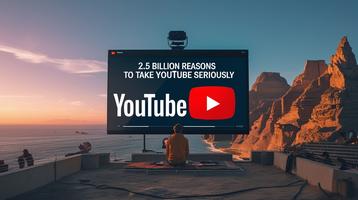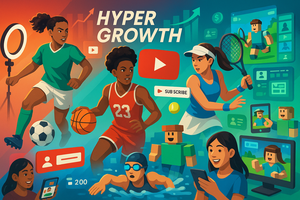- The Business of YouTube
- Posts
- How do you solve cannibalisation on YouTube?... Strategy secrets from leaders at Channel 4 & CBC 👀
How do you solve cannibalisation on YouTube?... Strategy secrets from leaders at Channel 4 & CBC 👀
The Business of YouTube
A weekly strategic lens for senior leaders into how YouTube is reshaping the business of technology, sports, music, entertainment, and culture.
 |  |
Welcome!
To your favourite newsletter, The Business of YouTube, brought to you by Paola Marinone and Bengü Atamer, founders of BuzzMyVideos and previously at YouTube and Google. We are bringing our exclusive insights from 20 years of experience leading strategy at YouTube and Google.
Deep-Dive: Cannibalisation… myth or reality? 🤔
 CBC, Senior Director of Entertainment Strategy and Audience Development |  Channel 4, Distribution & Partnerships Senior Lead (Social & Digital) |
The great cannibalisation debate… and why it might be a distraction
An ongoing debate amongst rights-holders within the YouTube space is centred on the cannibalisation of content. The age old tension of “will uploading on YouTube eat away at my owned, OTT, app or linear product?”
Well, on The Business of YouTube podcast we’ve had two senior leaders within the broadcaster space, Paul McGrath and Joe Harbinson from CBC and Channel 4 respectively, share their unique insights on YouTube from a broadcaster’s lens.
However, both Paul and Joe had refreshing perspectives on the great cannibalisation debate and how re-framing our perspectives can help to refine YouTube strategy. They both posed whether should we even be debating cannibalisation at all…?
As media consumption continues to fragment and audience behaviours evolves across formats and platforms, it’s not just about where the content goes. Its time to think about how you evolve alongside the viewers… let’s dive into it!
1. Migration is Inevitable ✈️
There’s often panic when viewership starts dipping in legacy formats. A fear that uploading on other platforms has led to audiences decreasing consumption on traditional broadcast channels.
But as Paul McGrath points out in the clip (full episode here), most of what we interpret as cannibalisation is actually audience migration. These dips in legacy viewership aren’t sudden losses.
Essentially a gradual evolution in where people choose to engage, shaped by time, generational habits, and the increasing fluidity of platforms.
Audiences don’t disappear, they shift. And if we only look at one metric (like TV ratings) without factoring in Shorts, VOD, or streaming minutes, then you’re reading a partial and potentially misleading story.
The cannibalisation question needs to be reframed. It’s a feature of a maturing ecosystem. This reframing allows us to approach the challenge with a renewed strategy that is better equipped to serve us in the long-term.
Viewers aren’t lost to YouTube or TikTok, they’re simply following formats that match their lifestyle and preferences. Whether it’s snackable content while commuting or a quick YouTube video on the TV whilst they eat dinner. These are media habits which are shaped by convenience, context and culture.
And as Paul McGrath discussed in the podcast, the data into the research he and his team carried out at CBC didn’t support the cannibalisation theory. If anything, they found YouTube unlocks broader reach, fandom, and funnel effects across platforms.
It’s about understanding why your audience moves, and what keeps them in the ecosystem once they get there.
2. Cannibalisation or stagnation? The Format Problem 🥱
Sometimes what gets labelled as cannibalisation isn’t about distribution at all, instead it can be a result of format decay. A reflection on the format itself which has not kept up with modern viewing habits.
Broadcast has traditionally operated on a fixed model. Consisting of appointment viewing, long-form pacing, and limited feedback loops. But today’s viewer, especially younger generations, are quicker to disengage with this format.
They’ve grown up in a content ecosystem where formats flex with their needs, content is on-demand, two-way interactions between creator and viewer, mobile-native and the algorithms deliver personalised content instantly to their feeds.
This isn’t a short attention span issue. It’s a product-market fit issue.
When highlights from a show on YouTube outperform a live match feed, it doesn’t necessarily signal cannibalisation. Sometimes it points to a mismatch in how content is packaged or when it’s delivered. The format has failed to meet the audiences where they are.
Cannibalisation, in this context, can be a convenient narrative, when the actual issue is that the format is no longer compelling enough on its own.
3. Platform Convergence > Platform Protection 🫂
The fear of cannibalisation often stems from seeing platforms as competitors. But what if they were collaborations?
When teams think in silos it feels like Broadcast over here, YouTube over there, the archive is repository and TikTok is an experiment. But this fragmented approach fails to create a cohesive strategy and experience.
Audiences don’t care where the content lives, it’s more about the value it brings in that moment.
An effective strategy should treat each platform as coexisting touch points in a wider ecosystem. Combining the unique strengths of linear, long-form and short-form in a cohesive strategy.
This means understanding how a shorts video can be used for discovery, how to retain audiences for long-form with viewer rewards, and the importance of broadcast TV’s appointment-setting to facilitate cultural moments. When these components work together, the whole is greater than the sum of its parts.
Joe Harbinson explains the impact of this cohesive strategy for Channel 4 in the clip below (full episode here).
For Channel 4, by creating YouTube-first IP it has strengthened its overall offering. Its helped them reach younger demographics and where it makes sense its allowed them to bring successful digital formats back to broadcast.
This is platform convergence in action.
Final Thoughts
The industry’s obsession with cannibalisation is often a distraction. But reframing cannibalisation allows us to ask better questions. Which in turn lets us create a more cohesive strategy, one that is better suited to the evolving behaviours of viewers.
Marrying the platforms together, allows your IP to be in sync.
Nobody’s winning, unless everybody’s winning.
Supercharge your YouTube channel with AI-powered YouTube optimisations and growth from FullScore. In minutes, you can identify the most effective optimisation opportunities for your channel.
The Business of YouTube Podcast 🗣️
Nick Cicero, Founder at Mondo Metrics, joins Paola to reveal secrets on data, platforms content & commercial strategy.
This week we are joined by Nick Cicero who is the founder of Mondo Metrics and previously founder of Delmondo (exited to Conviva). Nick has always been at the intersection of data and video platforms since day one. In this week’s episode he shares his insights in spotting opportunities for growing reach and revenue via data. Check out the episode below and let us know your thoughts!
Weekly YouTube Round-Up 📰
Social creators set to overtake traditional media. Forecasts from WPP Media show that in 2025, ad revenue from social creators will surpass traditional media. With platforms like YouTube, TikTok, and IG now earning more than TV and film combined. An expected growth of +20% this year and a projection of $376.6Bn by 2030.
YouTube Shorts adds Google Lens. YouTube is beta testing a new feature that integrates Google Lens into Shorts. Allowing users to pause a video and instantly search visual elements for product info, translation, and more.
YouTube TV expands multi-view. YouTube is extending its multi-screen capability to non-sports programming. Allowing viewers to customise and watch up to four channels simultaneously.
Learning Opportunities 🚨
We have exciting news to share with you this week! We’re hosting two webinars on important topics within the YouTube space, where Bengü will be sharing insights. Please sign-up on the links below and we would love to see you there!
2.5 Billions Reasons to Rethink Your YouTube Strategy: June 12th, 3:00PM
Women Sports: Hypergrowth with YouTube & Roblox: June 18th, 3:30PM
That’s all for this week!
Not yet a subscriber? Join business leaders from Disney to the Premier League, that read The Business of YouTube every week to get YouTube strategy breakdowns!
P.S Every week, we read all feedback we receive, which massively helps make The Business of YouTube as useful as possible for subscribers.
Vote on your thoughts from today's issue below. 👇
Was it useful? Help us to improve!
With your feedback, we can improve the newsletter. Click on a link to vote:
See you next week 👋
Paola and Bengü
 Paola Marinone, Founder & CEO BuzzMyVideos |  Bengü Atamer, Co-Founder & Director BuzzMyVideos |
The Business of YouTube is powered by BuzzMyVideos and Full Score.
About BuzzMyVideos: Founded by Ex Google/YouTube Executives, BuzzMyVideos is the leading AI YouTube Growth Platform that drives hyper-growth & new revenue from and on YouTube. With clients like AC Milan, World Aquatics, United World Wrestling, and many others, BuzzMyVideos leads the way on Scaling Growth & Revenue on YouTube.


